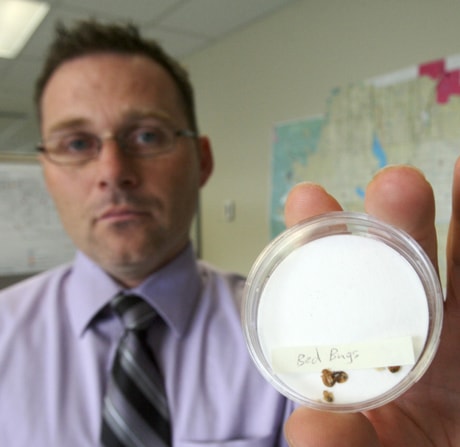There’s no doubt in pest exterminator Randy Unger’s mind that bedbug legions are growing.
“My first five or six years the industry I hadn’t even heard of a bedbug,” said Unger, who has been getting rid of unwanted critters for 16 years in Manitoba and Alberta.
“Probably the last six or seven there has been an insurmountable increase in activity.”
The bedbug boom seems to have started about six or seven years ago. The Red Deer exterminator now does at least two bedbug jobs a week, he figures.
Bedbugs crawled on to the front page of newspapers in Edmonton after Alberta Health Services ordered an apartment landlord to clear more than 40 suites of the blood-sucking pests. Tenants reported children with bite marks all over them, infested furniture and fruitless efforts to kill the tiny bugs.
David Brown, who is with Alberta Health Sciences environmental public health department for the central zone, said the office is getting a growing number of complaints.
“It’s my opinion that it definitely is on the increase,” said Brown, who has 15 years of public health experience. Where two of three bedbug calls a year was average, Brown said two or three a month is typical now. “I think we’re seeing almost a logarithmic increase in the number of complaints received.”
And for a number of reasons, including tenants not wanting to butt heads with their landlords or go to the trouble of stripping their apartments for fumigators, Brown knows his office is hearing only about a minority of infestation cases.
“What we know about people wanting to complain to the health department that’s probably a tip of an iceberg,” he said. “I would honestly suggest that’s about 10 per cent.”
His office wants to hear from people. Government staff can offer some good advice on what options are available and will approach hotel owners or landlords to get the problem fixed.
Brown is not sure why infestations are occurring so much more often.
“Whether that’s a result about people becoming better educated around the health department being interested in their complaint, or it’s a result of a bedbug infestation being much more prone because of the travel pattern of folks. (We’re) not clear on that.
“There could be a lot of factors that are behind the reasons we’re getting more bedbug complaints.”
On the plus side, the chemicals and other methods of getting rid of them are getting better, he said.
The bugs don’t transmit disease. But the bites do disrupt sleep and secondary infections can be caused by people scratching their itchy bites.
They hide in cracks and crevices and hang out in groups. They don’t fly or jump like fleas, but they crawl very quickly and can hide in seams, furniture joints or other tiny hiding spots.
Unger, who works for Poulin’s Pest Control Services, believes part of the bedbug problem is due to the reluctance of regulators to approve the most effective remedies because of concerns about toxicity.
“We’re constantly being bombarded with what not to use,” he said.
He understands the concerns, but without the best chemicals available exterminators are left having to do two or three treatments in many cases.
“For sure there’s lots of reasons to not use some of these harsh, harsh chemicals. But as professional licensed exterminators our hands are tied as to what we can use.”
It would be a different story if bedbugs passed on diseases. But since they don’t there is not the urgency to approve the best ways to eradicate them.
“I mean Alberta Pest Control Association is working hard at trying to get products OK’d and approved for use in bedbugs. We do have products more effective. It’s getting the regulations passed.”
pcowley@www.reddeeradvocate.com
Avoid sharing a mattress with bedbugs
There are a number of steps people can take to reduce their chances of sharing their mattress with bedbugs:
• Don’t throw coats, knapsacks, purses, briefcases or other outside items on the bed or other furniture. In hotels, hang your stuff up and keep it off beds.
• Avoid picking up used furniture, especially if it’s left by the curb. That “Couch for Free” deal may not be so good.
•If in a hotel or motel, pull back the bed cover and check the mattress. Small spots of blood on the mattress are telltale signs of bedbug bites.
• Regular vacuuming beds and washing sheets is a good idea.
• De-clutter your bedroom. Bedbugs love to hide out during the day and come out at night.
• Mattress slips can be used to keep bedbugs from getting out to bite people. They must be left on for at least 18 months because bugs can go a year without a blood meal.
